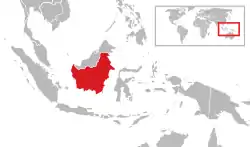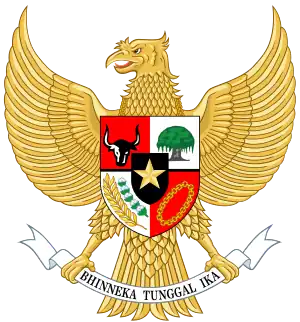Kalimantan | |
|---|---|
 Location of Kalimantan (Indonesia) in Borneo Island | |
| Coordinates: 1°S 114°E / 1°S 114°E | |
| Country | Indonesia |
| Province | West Kalimantan Central Kalimantan South Kalimantan East Kalimantan North Kalimantan |
| Largest cities | Balikpapan Banjarmasin Palangkaraya Pontianak Samarinda Tarakan Tanjung Selor |
| Population (2020 Census)[1] | |
| • Total | 16,625,796 |
| ISO 3166 code | ID-KA |
| Vehicle sign | DA KB KH KT KU |
| HDI | |
Kalimantan (Indonesian pronunciation: [kaliˈmantan]) is the Indonesian portion of the island of Borneo.[2] It constitutes 73% of the island's area. The non-Indonesian parts of Borneo are Brunei and East Malaysia. In Indonesia, "Kalimantan" refers to the whole island of Borneo.[2]
In 2019, President of Indonesia Joko Widodo proposed that Indonesia's capital be moved to Kalimantan, and in January 2022 Indonesian legislature approved the proposal.[3] The shift is expected to take up to 10 years.[4]
Etymology
Most Indonesian refer to The name Kalimantan as derived from the Sanskrit word Kalamanthana, which means "burning weather island", or island with a very hot temperature, referring to its hot and humid tropical climate. It consists of the two words kal[a] ("time, season, period") and manthan[a] ("boiling, churning, burning") because of Indianized culture [5] But the Native people of the Indonesian Borneo referred to their island as Pulu K'lemantan or "Kalimantan" when the sixteenth century Portuguese explorer Jorge de Menezes made contact with them.[6][7] Its association with the island and its people has also been attributed to British scientist and colonial administrator Charles Hose from the early 20th century.
Area

The Indonesian territory makes up 73% of the island by area, and 72.1% of its 2020 population of 23,053,723 (the population was 13,772,543 at the 2010 Census of Indonesia, and 16,625,796 at the 2020 Census).[8] The non-Indonesian parts of Borneo are of Brunei (460,345 in 2020[9]) and East Malaysia (5,967,582 in 2020), the latter comprising the states of Sabah (3,418,785) and Sarawak (2,453,677), and the federal territory of Labuan (95,120). The region within Indonesia is also known as Indonesian Borneo.
Kalimantan's total area is 539,237.77 square kilometres (208,201 sq mi).[10]
The widespread deforestation and other environmental destruction in Kalimantan and other parts of Indonesia has often been described by academics as an ecocide.[11][12][13]
Administrative divisions
Kalimantan is now divided into five provinces. It was administered as one province between 1945 and 1956, but in 1956 it was split into three provinces – East Kalimantan, South Kalimantan and West Kalimantan; then in 1957, the province of Central Kalimantan was created when it was split away from the existing South Kalimantan. There remained four provinces until 25 October 2012, when North Kalimantan was split off from East Kalimantan.
| Province | Area (km2) | Pop. (2005 Census) |
Pop. (2010 Census) |
Pop. (2015 Census) |
Pop. (2020 Census)[8] |
Density per km2 (2020) |
Provincial capital |
Largest metro |
|---|---|---|---|---|---|---|---|---|
| West Kalimantan | 147,307.00 | 4,042,817 | 4,393,239 | 4,783,209 | 5,414,390 | 36.8 | Pontianak | Pontianak |
| Central Kalimantan | 153,564.50 | 1,913,026 | 2,202,599 | 2,490,178 | 2,669,969 | 17.4 | Palangkaraya | Palangkaraya |
| South Kalimantan | 38,744.23 | 3,271,413 | 3,626,119 | 3,984,315 | 4,073,584 | 105.1 | Banjarbaru | Banjarmasin |
| East Kalimantan | 127,346.92 | 2,840,874 | 3,550,586 | 3,422,676* | 3,766,039 | 29.6 | Samarinda | Balikpapan |
| North Kalimantan | 72,275.12 | 473,424 | 524,526 | 639,639 | 701,814 | 9.7 | Tanjung Selor | Tarakan |
| Total | 539,237.77 | 12,541,554 | 14,297,069 | 15,320,017 | 16,625,796 | 30.8 | – | Banjarmasin |
* excluding North Kalimantan, split off from East Kalimantan with resulting population and area loss for the 2015 census.
Demographics
| Year | Pop. | ±% |
|---|---|---|
| 1971 | 5,154,774 | — |
| 1980 | 6,723,086 | +30.4% |
| 1990 | 9,099,874 | +35.4% |
| 1995 | 10,470,843 | +15.1% |
| 2000 | 11,331,558 | +8.2% |
| 2005 | 12,541,554 | +10.7% |
| 2010 | 14,297,069 | +14.0% |
| 2015 | 15,320,017 | +7.2% |
| 2020 | 16,625,796 | +8.5% |
| Sources: Statistics Indonesia[14] | ||
Ethnic groups
Number of the largest population of ethnic groups according to the 2010 census:
| Ethnicity | West Kalimantan | Central Kalimantan | South Kalimantan | North and East Kalimantan | Total |
|---|---|---|---|---|---|
| Banjarese | 14,430 (0.33%) |
464,260 (21.28%) |
2,686,627 (74.84%) |
440,453 (12.45%) |
3,605,770 (26.31%) |
| Dayak | 1,531,989 (34.93%) |
1,029,182 (46.62%) |
80,708 (2.23%) |
351,437 (9.94%) |
2,993,316 (21.78%) |
| Javanese | 427,238 (9.74%) |
478,393 (21.67%) |
523,276 (14.51%) |
1,069,605 (30.24%) |
2,498,512 (18.18%) |
| Malay | 1,484,085 (33.84%) |
87,348 (3.96%) |
3,681 (0.10%) |
6,053 (0.17%) |
1,581,167 (11.51%) |
| Buginese | 137,282 (3.13%) |
17,104 (0.77%) |
101,727 (2.81%) |
735,819 (20.81%) |
991,932 (7.22%) |
| Madurese | 274,869 (6.27%) |
42,668 (1.93%) |
53,002 (1.47%) |
46,823 (1.32%) |
417,362 (3.04%) |
| Chinese | 358,451 (8.17%) |
5,130 (0.23%) |
13,000 (0.36%) |
32,757 (0.93%) |
409,338 (2.98%) |
| Kutai | None | None | None | 275,696 (7.80%) |
275,696 (2.01%) |
| Sundanese | 49,530 (1.13%) |
28,580 (1.29%) |
24,592 (0.68%) |
55,659 (1.57%) |
158,361 (1.15%) |
| Batak | 26,486 (0.60%) |
12,324 (0.56%) |
12,408 (0.34%) |
37,145 (1.05%) |
88,363 (0.64%) |
| Others | 80,996 (1.85%) |
42,378 (1.92%) |
114,971 (3.18%) |
485,056 (13.72%) |
723,401 (5.26%) |
| Total | 4,385,356 (100%) |
2,207,367 (100%) |
3,613,992 (100%) |
3,536,503 (100%) |
13,743,218 (100%) |
Religion
Religion in Kalimantan (2022)[15]
Number of the largest population of religious groups according to the 2010 census:
| Religion | West Kalimantan | Central Kalimantan | South Kalimantan | North Kalimantan | East Kalimantan | Total |
|---|---|---|---|---|---|---|
| Islam | 2,603,318 (59.22%) |
1,643,715 (74.31%) |
3,505,846 (96.67%) |
378,478 (72.14%) |
2,655,227 (87.68%) |
10,786,584 (78.23%) |
| Protestantism | 500,254 (11.38%) |
353,353 (15.97%) |
47,974 (1.32%) |
109,358 (20.84%) |
228,022 (7.53%) |
1,238,961 (8.99%) |
| Roman Catholic | 1,008,368 (22.94%) |
58,279 (2.63%) |
16,045 (0.44%) |
29,366 (5.60%) |
109,263 (3.61%) |
1,221,321 (8.86%) |
| Hinduism | 2,708 (0.06%) |
11,149 (0.50%) |
16,064 (0.44%) |
288 (0.05%) |
7,369 (0.24%) |
37,578 (0.27%) |
| Buddhism | 237,741 (5.41%) |
2,301 (0.10%) |
11,675 (0.32%) |
3,879 (0.74%) |
12,477 (0.41%) |
268,073 (1.94%) |
| Confucianism | 29,737 (0.68%) |
414 (0.02%) |
236 (0.01%) |
175 (0.03%) |
905 (0.03%) |
31,467 (0.23%) |
| Other religions | 2,907 (0.07%) |
138,419 (6.26%) |
16,465 (0.45%) |
25 (0.00%) |
824 (0.03%) |
158,640 (1.35%) |
| Not Stated | 671 (0.01%) |
220 (0.01%) |
3 (0.00%) |
454 (0.09%) |
1,497 (0.05%) |
2,845 (0.02%) |
| Not Asked | 10,279 (0.23%) |
4,239 (0.19%) |
12,308 (0.34%) |
2,633 (0.50%) |
12,903 (0.43%) |
42,362 (0.31%) |
| Total | 4,395,983 (100%) |
2,212,089 (100%) |
3,626,616 (100%) |
524,656 (100%) |
3,028,487 (100%) |
13,787,831 (100%) |
See also
References
- ↑ Badan Pusat Statistik, Jakarta, 2021.
- 1 2 "Kalimantan". Britannica. Retrieved 2008-02-26.
- ↑ "Indonesia president proposes to move capital to Borneo | Reuters". Reuters. 2021-07-16. Archived from the original on 2021-07-16. Retrieved 2022-07-01.
- ↑ "Nusantara will replace Jarkarta as the new capital of Indonesia". 18 January 2022.
- ↑ "Central Kalimantan Province". archipelago fastfact. Retrieved 13 October 2014.
- ↑ "Notice historique du royaume Banjarmasin (Bornéo) par M. le Baron T. Van Capellen, lieutenant d'artillerie , aide-de-camp de S. Exc. le gouverneur-général des indes néerlandaises" [Historical record of the Banjarmasin Kingdom (Borneo) by Baron T. Van Capellen, lieutenant of artillery, aide-de-camp of His Excellency, the Governor General of the Dutch Indies]. Le Moniteur des Indes-Orientales et Occidentales [The Monitor of the East and West Indies] (in French). The Hague, Netherlands: Belinfant Brothers. 1847. pp. 164.
- ↑ "A Discourse Delivered at a Meeting of the Society of Arts and Sciences in Batavia, on the Twenty-fourth day of April 1813, being the Anniversary of the Institution, by the Honorable Thomas Stamford Raffles, President.". Verhandelingen van het Bataviaasch Genootschap, der Kunsten en Wetenschappen [Treatises of the Society of Arts and Sciences in Batavia]. Vol. 7. Batavia, Dutch East Indies: A. H. Hubbard. 1814. p. 21.
- 1 2 Badan Pusat Statistik, Jakarta, 2021.
- ↑ "Department of Economic Planning and Development – Population". www.depd.gov.bn. Retrieved 2017-12-12.
- ↑ "Indonesia General Info". Geohive.com. Archived from the original on 2009-10-15. Retrieved 2009-08-11.
- ↑ "Forensic Architecture". forensic-architecture.org. Retrieved 2023-07-05.
- ↑ "Explainer: What is ecocide?". Eco-Business. 2022-08-04. Retrieved 2023-07-05.
- ↑ Aida, Melly; Tahar, Abdul Muthalib; Davey, Orima (2023), Perdana, Ryzal; Putrawan, Gede Eka; Saputra, Bayu; Septiawan, Trio Yuda (eds.), "Ecocide in the International Law: Integration Between Environmental Rights and International Crime and Its Implementation in Indonesia", Proceedings of the 3rd Universitas Lampung International Conference on Social Sciences (ULICoSS 2022), Paris: Atlantis Press SARL, vol. 740, pp. 572–584, doi:10.2991/978-2-38476-046-6_57, ISBN 978-2-38476-045-9, retrieved 2023-07-05
- ↑ "Penduduk Indonesia menurut Provinsi 1971, 1980, 1990, 1995, 2000 dan 2010". Archived from the original on 2013-07-01. Retrieved 2013-07-17.
- ↑ "Jumlah Penduduk Menurut Agama" (in Indonesian). Ministry of Religious Affairs. 31 August 2022. Retrieved 29 October 2023.
External links
 Kalimantan travel guide from Wikivoyage
Kalimantan travel guide from Wikivoyage- MacKinnon, Kathy; Hatta, Gusti; Mangalik, Arthur; Halim, Hakimah (1996). The Ecology of Kalimantan. Periplus Editions. ISBN 9780945971733.
